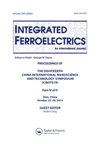人造宝石制品中掺fe2o3和mno2废玻璃
IF 0.7
4区 工程技术
Q4 ENGINEERING, ELECTRICAL & ELECTRONIC
引用次数: 0
摘要
摘要本文采用熔融淬火技术制备了(100−x)废玻璃:x Fe2O3/MnO2 (x = 0.0、0.2、0.4、0.6、0.8和1.0 mol%)中Fe2O3和MnO2掺杂对废玻璃物理和光学性能的影响。结果表明,随着Fe2O3/MnO2含量的增加,玻璃样品的密度和折射率增加。Fe2O3和MnO2掺杂废玻璃的颜色分别显示为黄色和紫色,这是由于Fe2O3在440 nm和1000 nm附近的吸光度使得Fe3+ (440 nm: 6A1g(S)→4T2g(G))和Fe2+ (1000 nm: 5T2g(D)→5Eg(D))离子在玻璃基体中均匀分布,而MnO2在486 nm附近的吸收波段由Mn3+离子(3d4构型)以八面体对称产生的单一允许6A1g(S)→4T1g(G)转变。此外,还研究了所有玻璃样品的CIE L*a*b*。结果表明,利用废玻璃生产玻璃是可行的,是利用废玻璃生产人造宝石的一种选择。关键词:废玻璃人造宝石光学披露声明作者未报告潜在利益冲突。本文章由计算机程序翻译,如有差异,请以英文原文为准。
Fe 2 O 3 - and MnO 2 -Doped Waste Glasses for Artificial Gems Products
AbstractThis work, the effect of Fe2O3 and MnO2-doped waste glasses in formula (100−x)waste glasses: x Fe2O3/MnO2 (x = 0.0, 0.2, 0.4, 0.6, 0.8, and 1.0 mol%) were prepared using melt quenching technique and all glass sampled were investigated on physical and optical properties. The results exhibited that the density and refractive index of glass samples increased with Fe2O3/MnO2 content increased. The color of Fe2O3 and MnO2-doped waste glasses displayed yellow and purple, respectively, because of absorbance for Fe2O3 near 440 nm and 1,000 nm which homogeneous distribution of Fe3+ (440 nm: 6A1g(S) → 4T2g(G)) and Fe2+ (1,000 nm: 5T2g(D) → 5Eg(D)) ions in the glass matrices while MnO2 around 486 nm as absorption band is assigned to a single allowed 6A1g(S) → 4T1g(G) transition which arises from the Mn3+ ions (3d4 configuration) in octahedral symmetry. Moreover, the CIE L*a*b* for all glass samples were also investigated. The results indicated that glass production from waste glasses is possible and option for recycling waste glasses to produce artificial gems.Keywords: Waste glassesartificial gemsoptical Disclosure StatementNo potential conflict of interest was reported by the author(s).
求助全文
通过发布文献求助,成功后即可免费获取论文全文。
去求助
来源期刊

Integrated Ferroelectrics
工程技术-工程:电子与电气
CiteScore
1.40
自引率
0.00%
发文量
179
审稿时长
3 months
期刊介绍:
Integrated Ferroelectrics provides an international, interdisciplinary forum for electronic engineers and physicists as well as process and systems engineers, ceramicists, and chemists who are involved in research, design, development, manufacturing and utilization of integrated ferroelectric devices. Such devices unite ferroelectric films and semiconductor integrated circuit chips. The result is a new family of electronic devices, which combine the unique nonvolatile memory, pyroelectric, piezoelectric, photorefractive, radiation-hard, acoustic and/or dielectric properties of ferroelectric materials with the dynamic memory, logic and/or amplification properties and miniaturization and low-cost advantages of semiconductor i.c. technology.
 求助内容:
求助内容: 应助结果提醒方式:
应助结果提醒方式:


